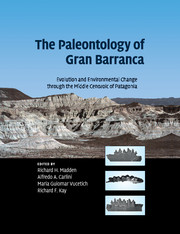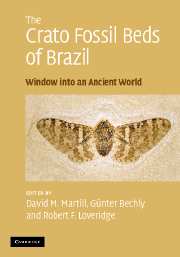The Paleontology of Gran Barranca
Evolution and Environmental Change through the Middle Cenozoic of Patagonia
£56.99
- Editors:
- Richard H. Madden, Duke University, North Carolina
- Alfredo A. Carlini, Universidad Nacional de La Plata, Argentina
- Maria Guiomar Vucetich, Universidad Nacional de La Plata, Argentina
- Richard F. Kay, Duke University, North Carolina
- Date Published: March 2018
- availability: Available
- format: Paperback
- isbn: 9781108445733
£
56.99
Paperback
Other available formats:
Hardback
Looking for an inspection copy?
This title is not currently available on inspection
-
Gran Barranca in Patagonia exposes the most complete sequence of middle Cenozoic paleofaunas in South America. It is the only continuous continental fossil record of the Southern Hemisphere between 42 and 18 million years ago, when climates at high latitudes transitioned from warm humid to cold dry conditions. This volume presents the geochronology of the fossil mammal sequence and a compilation of the latest studies of the stratigraphy, sedimentology, mammals, plants, invertebrates and trace fossils. It is also the first detailed treatment of the vertebrate faunal sequence at Gran Barranca, providing important new evidence about biotic diversity and evolution in the native species. A revised taxonomy allows a reevaluation of the origination and extinction of herbivorous mammals, marsupials, and xenarthrans, and the earliest occurrence of rodents and primates in southern latitudes. Academic researchers and advanced students in vertebrate paleontology, geochronology, sedimentology and paleoprimatology will value this wealth of new information.
Read more- New geochronology refines our understanding of mammalian evolution during a period of major faunal revolutions
- Includes new information enriching our understanding of climate variation during the middle Cenozoic
- Presents a new, more detailed, analysis of the fossil record - yielding information about the diversity of Patagonian environments and a more accurate measure of environmental change
Reviews & endorsements
'… the first detailed treatment of the vertebrate faunal sequence at Gran Barranca, providing important new evidence about biotic diversity and evolution in the native species … Academic researchers and advanced students in vertebrate paleontology, geochronology, sedimentology and paleoprimatology will value this wealth of new information.' The Eggs EGU Newsletter (the-eggs.org)
Customer reviews
Not yet reviewed
Be the first to review
Review was not posted due to profanity
×Product details
- Date Published: March 2018
- format: Paperback
- isbn: 9781108445733
- length: 458 pages
- dimensions: 280 x 218 x 25 mm
- weight: 1.2kg
- availability: Available
Table of Contents
Preface
List of contributors
1. Notes toward a history of vertebrate paleontology at Gran Barranca
Part I. Geology:
2. Physical stratigraphy of the Sarmiento Formation (middle Eocene - lower Miocene) at Gran Barranca, central Patagonia
3. Paleomagnetism and magnetostratigraphy of the Sarmiento Formation (Eocene-Miocene) at Gran Barranca, Chubut, Argentina
4. A geochronology for the Sarmiento Formation at Gran Barranca
Part II. Systematic Palaeontology:
5. Middle Eocene - Oligocene gastropods of the Sarmiento Formation, central Patagonia
6. Middle Tertiary marsupials from central Patagonia (early Oligocene of Gran Barranca): understanding South America's Grande Coupure
7. Middle Eocene - Early Miocene Dasypodidae (Xenarthra) of southern South America: biostratigraphy and palaeoecology
8. The 'Condylarth' Didolodontidae from Gran Barranca: history of the bunodont South American mammals until the Eocene-Oligocene transition
9. The Notohippidae (Mammalia, Notoungulata) from Gran Barranca: preliminary considerations
10. Rodent-like notoungulates (Typotheria) from Gran Barranca, Chubut Province, Argentina: phylogeny and systematics
11. The Leontiniidae (Mammalia, Notoungulata) from the Sarmiento Formation at Gran Barranca, Chubut Province, Argentina
12. Colhuehuapian Astrapotheriidae (Mammalia) from Gran Barranca south of Lake Colhue Huapi
13. The rodents from La Cantera and the early evolution of caviomorphs in South America
14. Colhuehuapian rodents from Gran Barranca and other Patagonian localities: the state of the art
15. A new primate from the early Miocene of Gran Barranca, Chubut Province, Argentina: paleoecological implications
16. Bats (Mammalia: Chiroptera) from Gran Barranca (early Miocene, Colhuehuapian), Chubut Province, Argentina
Part III. Patterns of Evolution and Environmental Change:
17. The Mustersan age at Gran Barranca: a review
18. A new mammal fauna at the top of the Gran Barranca sequence and its biochronological significance
19. Loessic and fluvial sedimentation in Sarmiento Formation pyroclastics,middle Cenozoic of central Patagonia
20. Paleosols of the Middle Cenozoic Sarmiento Formation, central Patagonia
21. Ichnofacies analysis of the Sarmiento Formation (middle Eocene-early Miocene) at Gran Barranca, central Patagonia
22. Phytolith studies in Gran Barranca (central Patagonia, Argentina), the middle-late Eocene
23. Stable isotopes of fossil teeth and bones at Gran Barranca as a monitor of climate change and tectonics
24. Hypsodonty and body size in rodent like notoungulates
Part IV. Regional Applications:
25. Vegetation during the Eocene-Miocene interval in central Patagonia: a context of mammal evolution
26. Paleogene climatic and biotic events in the terrestrial record of the Antarctic Peninsula: an overview
27. Mid-Cenozoic palaeoclimatic and palaeoceanographic trends in the southwestern Atlantic basins, a dinoflagellate view
28. Divisaderan land mammal age or local fauna?
Part V. Summary:
29. Gran Barranca: a twenty-three million year record of Middle-Cenozoic faunal evolution in Patagonia
Index.
Sorry, this resource is locked
Please register or sign in to request access. If you are having problems accessing these resources please email lecturers@cambridge.org
Register Sign in» Proceed
You are now leaving the Cambridge University Press website. Your eBook purchase and download will be completed by our partner www.ebooks.com. Please see the permission section of the www.ebooks.com catalogue page for details of the print & copy limits on our eBooks.
Continue ×Are you sure you want to delete your account?
This cannot be undone.
Thank you for your feedback which will help us improve our service.
If you requested a response, we will make sure to get back to you shortly.
×





